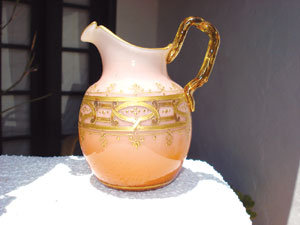
F from Santa Barbara once owned a large collection of art glass, now mostly sold. But he saved a little glass pitcher with “Gladys” written on it in enamel pant. Why and what is this?
This little pitcher tells a great story, for it serves as a great example of a World’s Fair collectible. The idea for a World’s Fair first occurred after the French Revolution in 1797. A French Minister of the Interior visited three factories traditionally devoted to the applied arts: Gobelins (tapestries), Sevres (porcelain) and Savonnerie (Carpets). He found warehouses full but the workers had deserted due to post-war instabilities. The Minister decided to showcase French arts of these industries on the Champs-Elyssee in Paris in 1798. The expositions became so successful that eleven more of these expositions followed, up until 1844, when a certain Prince Albert (Queen Victoria‘s husband) attended in Paris.
The Great Exhibition
Albert came up with the brilliant insight that England was naturally better at everything than France and England should hold an exposition herself. Against the wishes of notable English intellectuals Albert forged ahead. Karl Marx, in London, wrote that the English Exposition would be an “emblem of the Capitalist Fetishism of commodities.” The Great Exhibition of 1851 at the Crystal Palace was born, a universal fair which attracted 6-million people, a third of the population of England.
Trophy industries of 28 countries were honored in a great greenhouse 1851 feet long, in Hyde Park, London. Over a six month period attendees included Queen Victoria, Charles Darwin, Charlotte Bronte, Charles Dickens, Lewis Carroll, George Elliot, Karl Marx, and Alfred, Lord Tennyson. Here the idea of a world’s fair souvenir came into fashion, and souvenirs ranged from hankies to glassware to toys to coins to architectural banks. Everyone has one World’s Fair memento somewhere. And why not?
The World’s Fair, an invention of the 19th century, saw the following:
- 1851 London
- 1855 Paris
- 1862 London
- 1867 Paris
- 1873 Vienna,
- 1876 Philadelphia
- 1878 Paris
- 1893 Chicago
- 1897 Brussels
- 1900 Paris
- 1904 St. Louis, etc.
My family owns those stupid useless souvenir spoons, posters, programs, guidebooks. I myself visited the 1964-65 New York World’s Fair, and I possess a little Statue of Liberty to prove it.
F’s glass pitcher is cross-collectible
I consider this pitcher a desirable type of art glass, as well as a World’s Fair souvenir. Little pitchers from World’s Fairs became a favorite collectible. EBay lists these from 1904 St. Louis, 1893 Chicago, Spokane 1974, Knoxville 1982, Seattle 1909. The most common glass pitcher hails from 1904, a clear glass “flashed” with ruby coating and inscribed with one’s name.
F’s pitcher is made by Mt. Washington, which patented a process that enabled the glass, when heated, to change in gradations from pinkish to coral to yellow. The glass then has enamel or colorene (applied ground glass) decoration. Thus, the name, “Gladys,” is monogrammed on the pitcher. I surmise this little souvenir pitcher came from the 1893 Columbian Exposition in Chicago, the “White City,” to celebrate Christopher Columbus‘s 400 Anniversary. Daniel Burnham designed the unified white classical buildings with landscapes by Frederick Law Olmsted. This done in the Beaux Arts style, namely, highly formal French Neoclassical (think Alabaster City or The City Beautiful) the grand style of urban planning.
Everything about the Columbian Exposition (beauty, order, classicism, symmetry, gleaming surfaces – and American Exceptionalism) echoes in F’s little time-capsule of a souvenir.
Ironically, in the City of White, a black figure emerged
Herman Webster Mudgett, the first documented American serial killer (over 200 murdered), plucked women and children from the Columbian Exposition. He tortured and murdered them in a Columbian Exposition hotel designed for murdering purposes. Not only Herman’s vile deeds, but Burhams’ white architecture is beautifully explored in Erik Larson‘s The Devil and the White City: Murder, Magic, and Madness at the Fair that Changed America (2003). What a tale the little pitcher tells! It is worth $200, by the way.